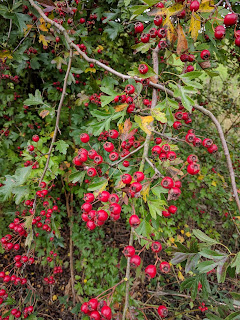I'm happy with how courteous and respectful most drivers are, but there's always a few idiots and it only takes one to cause a serious problem, so I like to get off the roads. I've been wandering the paths and tracks near home on my new bike and loving the fact that hills are now not obstacles but instead are fun.
Today I followed a route I've walked and cycled for years and I thought I knew very well, but as usual, when you take a close look at familiar things new stuff emerges. Mapping makes you look closely.
I have the file of Public Rights of Way that the East Riding of Yorkshire council have finally released under OGLv3. I am grateful to Robert Whittaker for his persistent and skillful chasing of the council. He got the data released under the open licence where I had failed.
In general the data shows where rights of way are present and shows the footpaths, bridleways and byways as expected. Today I followed a route which used various rights of way and all were signed with the yellow and green arrows and some fingerboards all put up by the council. You would expect these signs on the ground to match the data in the file from the council, but no.
There is a part of Elloughton Dale where the path drops down a steep slope to the road through the valley. You can then follow the road for a couple of hundred metres before turning off to climb the other side of the valley. The descent is through woods and is steep enough that steps with wooden risers have been cut to prevent erosion. This however is not the route I took, because there is a more direct route that comes out of the woods opposite the point where the ascent starts, thus it avoids the steps and there is no need to use the road except to cross it. When I first used this more direct route, probably forty years ago, it was unofficial and the land owner put up barbed wire to stop it being used, but after a while a gate appeared instead (he was probably fed up with replacing the wire) and this was the preferred route to take. More recently, at least twenty five years ago, public right of way signs appeared both at the roadside and at the point in the woods where the route down the steps and this newer route diverge.
This new route is not part of the data the East Riding of Yorkshire council publish and it is not on their 'Walking the Riding' map they publish on their website. So which to believe, council signs on the ground or the data they reluctantly published? Maybe their reluctance to publish was partly because they know the data is out of date. I have used what I know on the ground to map the route, though I can't add a prow_ref tag because that's not displayed on any of the signs.
 |
| Hawthorn looking good |
 |
| No fruit on the brambles |
 |
| Elder looking shrivelled |